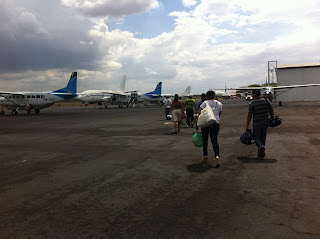The one with the door open was the plane I took.
The RAAN from the air, getting close to Puerto.
Puerto from the air, and that is the ocean on the horizon.
The view from my room at the house of the family I'll be staying with. Those are sheep.
I will be working with the organization Health Poverty Action and their partner organization Movimiento de Mujeres Nidia White, supporting their joint sexual and gender based violence (SGBV) education and prevention projects. The Movimiento provides "integrated" services to survivors of violence including legal, psychological, and medical services and they run the only shelter in the entire RAAN region that is available for survivors who are in immediate danger or who have no where else to go. They also provide education and awareness-building services in the form of trainings to community health promoters, traditional leaders, and directly to community members. I spent my first few days at work touring the facilities, talking with each staff member, planning with the Health Poverty Action coordinator, and observing trainings in the communities. Yesterday we had a meeting with the entire team and with two outside consultants who were hired by the project to discuss the baseline study on knowledge, attitudes and practices related to violence that they hope to carry out in the next couple of weeks. I think it was definitely the first time I had ever discussed indicators, variables, methods, etc., in Spanish! It was interesting and productive, but unfortunately we didn't make it very far through reviewing the survey that the consultants had designed. I found out that the statistical program they use here is SPSS, which is the only one I happen to know.
Outside of the Movimiento de Mujeres building.
Inside of the building.
My first impression of Puerto is that it is a pretty interesting place because of how culturally and ethnically diverse it is. People here speak three main languages: Miskito, Spanish, and Creole English, and some people speak all three. It was explained to me that although almost everyone is at least somewhat inter-mixed ethnically (between Miskito, Mestizo (Hispanic), Afro-descendent, and various other indigenous groups such as Mayagna), everyone has a single ethnic identity that they most identify with based on how they were raised and the primary language they speak at home. All of the staff and most adults in Puerto can speak Spanish because that is what is taught in school. However, when speaking with each other they move seamlessly between all three languages, and everyone seems to follow the conversation. Needless to say, it makes me wish I spoke more that just Spanish. Here is Puerto, the majority speak Miskito at home, including the family I am living with. I have decided that I wouldn't necessarily have to be able to speak it because I could always respond in Spanish, but it would be helpful to be able to understand it. So far it has been fascinating to just listen to Miskito because of the way it incorporates a lot of Spanish words, but also English words (e.g. family, "siknis").
One of the Movimiento's educators facilitating a community workshop on types of violence and the new law against gender based violence in a barrio of Puerto.
The community members who came.
I tried to upload a video of the workshop so that you can all hear what Miskito sounds like, and Spanish speakers can hear how Spanish words and even entire sentences in Spanish are used in conversation...but it keeps telling me there is an error. I will try again later.
So far, I have been mostly eating with the family and the food has been pretty good. There are not many fruits or vegetables though since most things have to be flown in from Managua. They eat a lot of turtle here. The other day I had it twice: once at lunch and then again at dinner mixed into spaghetti. It was different that any other meat I've ever tried, though not bad. I am pretty sure sea turtles are endangered but people eat them anyways, as it is a traditional food here.








No hay comentarios:
Publicar un comentario